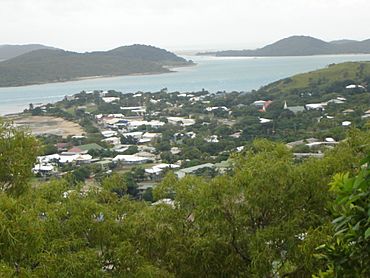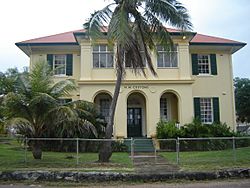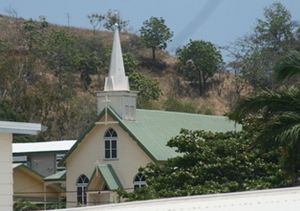Thursday Island facts for kids
Quick facts for kids Thursday IslandQueensland |
|||||||||||||||
|---|---|---|---|---|---|---|---|---|---|---|---|---|---|---|---|

View of the township of Thursday Island
|
|||||||||||||||
| Population | 2,805 (2021 census) | ||||||||||||||
| • Density | 801/km2 (2,070/sq mi) | ||||||||||||||
| Postcode(s) | 4875 | ||||||||||||||
| Elevation | 8.0 m (26 ft) | ||||||||||||||
| Area | 3.5 km2 (1.4 sq mi) | ||||||||||||||
| Time zone | AEST (UTC+10:00) | ||||||||||||||
| LGA(s) | Shire of Torres | ||||||||||||||
| State electorate(s) | Cook | ||||||||||||||
| Federal Division(s) | Leichhardt | ||||||||||||||
|
|||||||||||||||
|
|||||||||||||||
|
Native name:
Waiben
Nickname: TI
|
|
|---|---|

A map of the Torres Strait Islands showing 'Waiben' in the south-western waters of Torres Strait
|
|
| Geography | |
| Location | Northern Australia |
| Archipelago | Torres Strait Islands |
| Adjacent bodies of water | Torres Strait |
| Area | 3.5 km2 (1.4 sq mi) |
| Highest elevation | 104 m (341 ft) |
| Administration | |
| State | Queensland |
Thursday Island, often called TI, is a small island in the Torres Strait Islands. This group of islands has at least 274 small islands in the Torres Strait. TI is about 39 kilometers (24 miles) north of Cape York Peninsula in Far North Queensland, Australia.
Thursday Island is also the name of the main town on the island. This town was once known as Port Kennedy. Another small town, Rose Hill, is on the north-eastern tip of the island. In 2021, about 2,805 people lived on Thursday Island.
Contents
Exploring Thursday Island's Geography
Thursday Island covers an area of about 3.5 square kilometers (1.4 square miles). The highest point on the island is Milman Hill, which is 104 meters (341 feet) above sea level. This hill was once a defense site during World War II.
Thursday Island is the main administrative and business center for the Shire of Torres. It also serves as a key center for the wider Torres Strait Island Region.
A Look into Thursday Island's Past
People have lived on Thursday Island for thousands of years. The Torres Strait Islanders are the original inhabitants. Evidence from nearby islands shows that people have lived in this area for at least 2,600 years.
How Thursday Island Got Its Name
In 1848, a British Navy captain named Owen Stanley explored the area. He named this island "Friday Island" and another island "Thursday Island". However, in 1855, the names were swapped. This was done to keep the islands named after days of the week in order from east to west.
The first European settlement in the Torres Strait was Somerset, established in 1864. But its port was dangerous for ships. So, in 1875, the port was moved to Thursday Island. The new port was called Port Kennedy. The town that grew there was also called Port Kennedy until 1962, when it became Thursday Island.
In 1877, the Queensland Government set up an administrative center on the island. By 1883, over 200 pearling boats were based there.
The Pearl Trade on Thursday Island
A very profitable pearling industry started on Thursday Island in 1884. This attracted many workers from places like Japan, Malaysia, and India. Some Japanese divers were brought to work here for a set time. Others stayed longer, helping with boat building and renting out boats. Many people from other Pacific Islanders also worked in this industry. Some were even brought against their will.
The pearling industry mainly focused on harvesting pearl shells. These shells were used to make things like shirt buttons. The local pearl oyster is called the Golden Lip Oyster. Even though the pearling industry is not as big now, the mix of cultures from that time is still seen on the island today.
Shell Harvesting and Diving
Besides pearls, trochus shells were also collected. These shells were mostly sent overseas as raw material. Finding actual pearls was rare and a bonus for the boat owners or crew. The boats used were beautiful two-masted luggers.
Divers would free dive in shallow water. In deeper water, they used special diving suits with air supplied from the surface. A hand-powered air compressor was used to pump air to the divers. The waters around the Torres Strait were often murky, making visibility very poor. Even though divers didn't go extremely deep, many suffered from "the bends" (a diving sickness), and deaths were common.
Telegraph, Trade, and Cyclones
In 1887, a telegraph station opened on Cape York. It connected to Thursday Island through an undersea cable. This helped with communication.
In the late 1800s and early 1900s, Thursday Island was a regular stop for ships trading between Australia and Southeast Asia. In 1890, a ship called the Quetta hit a hidden reef and sank quickly. More than 130 people lost their lives. The Anglican Church on Thursday Island was later named the Quetta All Souls Memorial Cathedral in their memory. Today, it is called All Souls and St Bartholomew Church.
In 1899, Cyclone Mahina hit the area. It destroyed many pearling boats that were sheltering nearby, causing huge losses of ships and lives.
The Fort on Thursday Island
A fort was built on Battery Point in 1892 to protect the island. This was because people feared a Russian invasion. The fort stopped being used in 1927. Today, it is a historic site on the island.
Thursday Island in the 20th Century
The local pearling industry slowly declined until World War II. After the 1950s, plastic buttons became popular, reducing the demand for pearl shells.
The Thursday Island Customs House opened in 1938.
During World War II, Thursday Island became a military headquarters. It was a base for Australian and United States forces. In January 1942, civilians were moved off the island. People of Japanese background were held in special camps. They did not return until after the war, and many ethnic Japanese were sent back to Japan.
Thursday Island was not bombed during the war. Some believe this was because many Japanese pearl divers were buried there. Others think the Japanese believed their people were still living on the island. However, nearby Horn Island was heavily bombed because it had an airbase used by the Allies.
After the war, an airline service started from Cairns to Thursday Island. Passengers would land on Horn Island and take a ferry to Thursday Island, which is still done today.
In the 1950s, people tried to start cultured pearl farms. But many were destroyed by disease in the 1970s. This industry still exists around the island today.
In the 1970s, there was a discussion about whether some Torres Strait Islands should become part of Papua New Guinea. However, the Torres Strait Islanders insisted they were Australians. After many talks, all the Torres Strait Islands, including Thursday Island, remained part of Australia.
People and Culture
In 2021, the population of Thursday Island was 2,805 people.
Languages Spoken
Torres Strait Creole is the main language spoken by the Islanders on Thursday Island. Another important language is Kalaw Lagaw Ya. English is also spoken. The original language of the island is Kaiwaligau Ya, a dialect of Kalaw Lagaw Ya.
Places of Interest
Thursday Island has several important historical sites:
- Green Hill Fort, Chester Street: This is the old fort built to protect the island.
- Quetta Memorial Precinct, Douglas Street: A place to remember the Quetta ship disaster.
- Our Lady of the Sacred Heart Church, 120 Douglas Street: A historic church.
- Thursday Island Cemetery, Summers Street: This cemetery includes a special Japanese Cemetery.
- Thursday Island Customs House, 2 Victoria Parade: The old customs building.
The Gab Titui Cultural Centre, opened in 2004, shows off both old and new Islander artworks.
Island Life and Economy
Thursday Island is one of the two bases for the Torres Straits Pilots. These are expert sailors who guide ships safely through the tricky waters of the Torres Strait.
The island has the main hospital and courts for the area. It is also a center for higher education and government offices. Banks and phone services are available.
Thursday Island gets some of its water from a nearby island through pipes. It also uses two wind turbines to generate some of its electricity.
The island's economy relies on its role as an administrative center. Pearling, fishing, and a growing tourism industry also support it. Famous visitors have included the writer Somerset Maugham. Many tourists visit for day trips from cruise ships.
Thursday Island's Climate
Thursday Island has a tropical savanna climate. This means it has a wet season from December to April and a dry season from May to November. Temperatures are hot all year round. The average high temperatures range from 29.0°C (84.2°F) in July to 32.1°C (89.8°F) in November.
The island gets about 1781.2 mm (70.1 inches) of rain each year, mostly in late summer. The highest temperature ever recorded was 37.9°C (100.2°F). The lowest was 15.1°C (59.2°F).
| Climate data for Horn Island (10º34'48"S, 142º17'24"E, 4 m AMSL) (1995-2024 normals and extremes, humidity only to 2010) | |||||||||||||
|---|---|---|---|---|---|---|---|---|---|---|---|---|---|
| Month | Jan | Feb | Mar | Apr | May | Jun | Jul | Aug | Sep | Oct | Nov | Dec | Year |
| Record high °C (°F) | 36.7 (98.1) |
35.4 (95.7) |
34.8 (94.6) |
33.9 (93.0) |
32.2 (90.0) |
32.4 (90.3) |
31.8 (89.2) |
31.8 (89.2) |
35.8 (96.4) |
35.2 (95.4) |
35.1 (95.2) |
37.9 (100.2) |
37.9 (100.2) |
| Mean daily maximum °C (°F) | 30.9 (87.6) |
30.6 (87.1) |
30.5 (86.9) |
30.6 (87.1) |
30.1 (86.2) |
29.5 (85.1) |
29.0 (84.2) |
29.2 (84.6) |
30.2 (86.4) |
31.2 (88.2) |
32.1 (89.8) |
32.0 (89.6) |
30.5 (86.9) |
| Mean daily minimum °C (°F) | 25.2 (77.4) |
25.1 (77.2) |
25.1 (77.2) |
25.4 (77.7) |
24.9 (76.8) |
24.1 (75.4) |
23.3 (73.9) |
23.2 (73.8) |
24.0 (75.2) |
24.9 (76.8) |
25.8 (78.4) |
25.9 (78.6) |
24.7 (76.5) |
| Record low °C (°F) | 21.5 (70.7) |
21.1 (70.0) |
21.1 (70.0) |
21.1 (70.0) |
17.7 (63.9) |
18.1 (64.6) |
16.0 (60.8) |
15.3 (59.5) |
15.1 (59.2) |
18.4 (65.1) |
19.9 (67.8) |
20.3 (68.5) |
15.1 (59.2) |
| Average precipitation mm (inches) | 425.3 (16.74) |
423.3 (16.67) |
360.2 (14.18) |
236.5 (9.31) |
64.1 (2.52) |
14.3 (0.56) |
10.2 (0.40) |
6.8 (0.27) |
5.1 (0.20) |
12.6 (0.50) |
41.3 (1.63) |
186.6 (7.35) |
1,781.2 (70.13) |
| Average precipitation days (≥ 1.0 mm) | 18.5 | 17.7 | 17.0 | 11.6 | 6.7 | 3.8 | 3.3 | 1.9 | 0.9 | 1.9 | 3.1 | 10.1 | 96.5 |
| Average afternoon relative humidity (%) | 75 | 78 | 76 | 74 | 70 | 69 | 65 | 64 | 64 | 64 | 66 | 71 | 70 |
| Average dew point °C (°F) | 24.4 (75.9) |
24.6 (76.3) |
24.3 (75.7) |
23.8 (74.8) |
22.6 (72.7) |
21.7 (71.1) |
20.4 (68.7) |
20.1 (68.2) |
20.8 (69.4) |
21.7 (71.1) |
23.0 (73.4) |
24.1 (75.4) |
22.6 (72.7) |
| Source: Bureau of Meteorology (1995-2024 normals and extremes, humidity only to 2010) | |||||||||||||
What to Do on Thursday Island
Thursday Island has many services for the community. These include:
- A sporting complex and gym.
- A public library called Ngulaig Meta Municipal Library.
- Parks like ANZAC Park and Ken Brown Oval.
- A community pharmacy, general store, butcher, and bank.
Sacred Heart Catholic Church is located on Douglas Street.
Learning on Thursday Island
There are several schools on Thursday Island:
- Tagai State College is a government school for all ages, from early childhood to Year 12. It has 17 campuses across the Torres Strait, including two on Thursday Island.
- The primary school campus (Early Childhood-Year 6) is on Hargrave Street.
- The secondary school campus (Years 7-12) is on Aplin Road.
- Our Lady of the Sacred Heart School is a Catholic primary school (Prep-Year 6) on Normanby Street.
- The Torres Strait Campus of the Tropical North Queensland TAFE Institute is also on the island. TAFE offers vocational training for older students.
Famous People from Thursday Island
Many notable people have come from or lived on Thursday Island, including:
- Henry Gibson "Seaman" Dan: An award-winning musician from the Torres Strait.
- John Douglas: A former Premier of Queensland who later lived on the island.
- Matthew Elliott: An Australian professional rugby league coach and former player.
- Tiarna Ernst: A professional AFLW player who won a championship.
- Tommy Fujii: A pearl shell diver as a boy, who later became a businessman.
- Elma Gada Kris: A dancer, choreographer, actor, and NAIDOC award winner.
- The Mills Sisters: A group of three musical sisters who performed across the Pacific and in Europe.
- Danny Morseu: A professional basketball player.
- Bernard Namok: The designer of the Torres Strait Islander flag.
- Jesse Williams: The first Indigenous Australian to play American football for the Alabama Crimson Tide.
See also
 In Spanish: Isla Thursday para niños
In Spanish: Isla Thursday para niños





